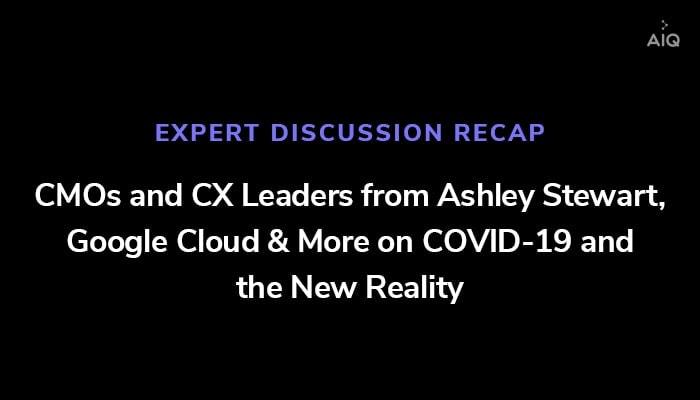CMOs and CX Leaders from Ashley Stewart, Google Cloud and More on COVID-19 and the New Reality

On 4/8 ActionIQ hosted a virtual forum where brand executives and industry leaders discussed how they are adapting to manage the customer experience and meet rapidly changing customer needs during the global pandemic crisis.
Moderated by ActionIQ’s Ryan Greene and Tamara Gruzbarg, the distinguished panel featured:
- Patrick Adams, Named as one of Forbes Top 50 Most Influential CMOs, previously Head of Consumer Marketing and executive at PayPal, Victoria’s Secret, Citi and Chase
- Nick Antoniades, Vice President, CRM and analytics at Ashley Stewart, previously a marketing leader at Bed Bath & Beyond, The Vitamin Shoppe and New York & Co.
- Brian Carlson, Founder of RoC Consulting, previously a VP of Content Marketing at Travelers and Editor-in-Chief at IDG
- Chitra Iyer, Editor-in-Chief of Martech Advisor, former analyst at Gartner and Forrester, previously a marketing leader at Tata Sky and Procter & Gamble
- Carrie Tharp, Vice President, Retail & Consumer at Google Cloud, previously a senior marketing executive at Fossil Group and Travelocity
Immediate Customer Experience Priorities
The conversation kicked off with a discussion of near term strategies for navigating the impact of the pandemic crisis on the consumer experience.
#1 – For Brands, Marketing is Now a Tale of Two Cities
Retailers and brands who are in the “essential” category such as grocery and household goods are experiencing a completely distinct set of market dynamics than those designated “non-essential,” such as apparel and beauty. Each must adjust strategies specifically to their customers and products.
In non-essential categories, the purchase intent data is sobering. In the 18-54 age group, only 15% intend to make a purchase in the next 3 weeks. Marketers in this category need to focus more on their brand-level connection with customers—otherwise picking their spots carefully.
There are some areas of opportunity: Americans are looking for a sense of normalcy, and apparel, beauty and similar brands can connect with consumers in a way that can lift their spirits. People seeking comfort are turning to categories such as loungewear, casual wear, and activewear which are more relevant and seeing active purchasing.
In grocery and essentials, demand is up. But the supply chain and delivery channels are stressed. From a digital advertising standpoint, brands might have previously bid on terms related to paper towels and toilet paper—this no longer makes sense because supply cannot support demand. Consumers are extremely interested in how, when and where they can purchase. Communicating about safety practices, hours, availability and what services the grocer is offering, such as BOPIS and curbside pickup is key. So ad spend has shifted to communicating those offerings.
#2 – More than Ever, Messaging Must Be Attuned to Your Customer
It’s a tale of two cities for consumers as well. While a white collar worker may be experiencing social isolation—a blue collar worker might be struggling to make rent. Messages appropriate for one will seem irrelevant, tone deaf or insensitive to the other.
Most importantly, you need to know your customer. If ever there was a time to practice stepping into their shoes, it’s now. “We care about you” messages are nice, but back it up by answering questions, solving problems, and proving you care about the customer by giving them something without immediately expecting something in return. Customers will remember your brand because you did the right thing at the right time, and treated them with respect during the crisis.
#3 – Relevance is Everything
Panelists emphasized that brands need to continue their journeys towards achieving personalization at scale, understanding your customer down to an individual level. But in the immediate response to the crisis, it’s relevance that should be top of mind.
Make your brand relevant by thinking about the customer as the core of what you do. Take on a mindset of service, support, and solving pain points. Think deeply about your customers’ relationships to your brand and your products. Use your data to guide you. It’s also a good time to review your content strategy and consider how it plays a role in brand-building, engagement and providing genuine value to consumers at the top, middle, and bottom of the funnel.
If you are truly and authentically relevant, you can earn the right to continue to promote your products in addition to your brand—where and if it’s appropriate.
#4 – Take a Considered Approach to Promotions
Many brands are sitting on fully stocked inventories of spring and summer merchandise, and consumer spending is down. Promotions will be necessary in this environment. But panelists recommend taking a very considered approach.
During the 2008 housing crash, brands leaned heavily on broad-based promotions to get through that crisis. But for years afterwards, many of those brands remained (unwillingly) promotion driven and struggled to return to full-price, full margin sales. To head off similar challenges, brands should seek to strike a balance in terms of how hard they lean on promotion tactics.
One approach that minimizes brand impact is to use personalization techniques—communicating directly with customers either 1:1 or via microsegments—about promotions exclusive to them. This allows promos to be deployed contextually with each customer, and without broadcasting price reductions, resulting in reduced brand impact.
But we are in uncharted territory, and there are no hard and fast rules. Take Rag and Bone, for example, whose founder posted a letter about why they’re lowering prices. They found a way to make their very public promotional strategy relevant and consistent with their brand values. It works.
#5 – Opportunities for Acquisition Do Exist
In the previous virtual forum including panelists from Dunkin’, Gap and Theory, panelists recommended dialing back on acquisition. In this discussion—while our experts agreed they’ve all reduced acquisition and shifted focus to CRM—they also highlighted that opportunities for acquisition exist.
There are pockets of consumers who have needs that aren’t being adequately served right now. By reviewing your audiences, leveraging your data, and carefully testing and learning, it’s possible to identify these opportunities. Accompanied by relevant and appropriate messaging, you can win new customers.
What Will be the Long Term Impact of This Crisis on CX?
Our panelist continued the discussion identifying some of the trends and changes that may be here to stay well into the future.
#1 – Brands Will Build Strategies to Move Offline Shoppers Online
For some time, the talking points have been to move away from channel-first to customer-first. Now, an entire channel—brick and mortar—went down practically overnight. For omnichannel brands where knowledge of the customer is an asset independent of channel, your data still stands. Brands will use their depth of knowledge of the customer as a bridge to connect in new ways.
This can be done by first building out an engagement strategy along three tracks—thinking about your historically 1)omnichannel, 2)multichannel and 3)store-only shoppers—and creating a plan for each group. Migrating store-only shoppers to online will be the biggest challenge. Look to social media as an effective way to begin increasing engagement with this group. It’s not a flip of the switch, but over time—through education, persistent communication, and conveying the value of the digital experience—you can convert offline customers to online.
#2 – Digital Will Extend to Serve a New Demographic
Necessity is the mother of invention. And out of necessity, a new demographic of previously store-only shoppers is seeking to go digital. (One panelist shared the story of his 85 year old mother learning how to use Venmo to pay for a grocery delivery.)
The fact is, most tech—such as digital payment systems—does not take into account the 60+ year old demographic in its design. Bringing on this new user raises needs around education, usability, accessibility and risk. It may even require an end-to-end retooling of digital experiences and their capabilities. Brands will need to adapt. Data, testing and learning will be key.
#3 – Brands Will Raise Their Expectations of Data and Tech
Knowing the customer and having the agility to serve their individual and changing needs is critical going forward. Data is the linchpin—and data about customers and their behavior needs to flow through every system and across every department to make it work.
Today, many marketing initiatives have built in channel bias in that their KPIs roll up to the channel and not to the customer. In the future, marketers will build ground-up journeys that are channel agnostic, and take into account the delivery capability of every part of the organization. You can come up with a great new promotion, but will the operations be there to fulfill the orders on promoted items?
So before looking at tech or investing in tech, brands will put in the work to make sure their data strategies are in order. Then, they’re going to expect more from their technology in terms of how it supports their data strategy, and orchestrates and activates that data in a customer-centric manner.
#4 – Martech Stacks Will Streamline
Today’s martech stacks are also built out with a channel bias. The result is “frankenstacks” loaded with point solutions, many of them redundant. And more and more time and resource is invested in systems integrations, trying to get point systems to pass data back and forth to each other.
Increasingly, marketers will turn to strategies and systems—such as CDPs—that facilitate centralizing their customer data and customer insights. This will open up the opportunity for marketing departments to rationalize their stacks. Eliminating redundant tools, and stripping away systems that were designed to support prior business models.
In a time when everyone must take great care with how they invest company resources, every campaign, every tactic and every tool matters. Not only will streamlining preserve much needed cash for brands, but it will enable the business agility they need to succeed and thrive going forward.
#5 – Working From Home is Here to Stay
Many consumers will be working from home for the foreseeable future. As will many of us marketers. Brands will take more advantage of the fact that certain teams can work just as effectively—or even more effectively—in remote settings. Take content creation, for instance: editorial, content and digital can all be done remotely. For writers, an office is a much less productive environment (with constant questions and meetings) than their individual remote workspace where they can intently focus on delivering relevant, valuable content.
The tools and technology exist for remote work and collaboration. The effort will lie in the cultural shift necessary to support it and drive it to succeed. For executives, remote work will likely prove a greater challenge to their leadership style. But many existing management techniques, from 1:1 meetings to group lunches and happy hours can successfully be replicated over videoconferencing. This is a new frontier—but brands can and will persevere, and also find opportunities for new growth.
Don’t Miss the Next Discussion in this Series
Stay tuned for our upcoming Customer Experience Management: The New Reality virtual forums on Tuesday, April 14 @ 4pm ET, Wednesday, April 22 @ 2pm ET and Thursday, April 30 @ 4pm ET featuring executives from American Eagle Outfitters, Vera Bradley, BCG, Cowen and Company, Kate Spade, Shiseido and more. If you haven’t already done so, register now!





